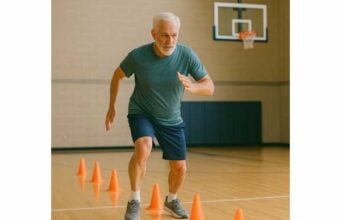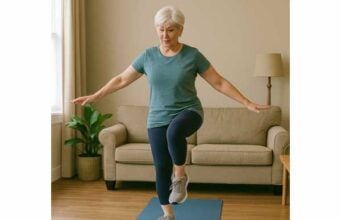Fitness
Home Fitness
Fitness for Longevity: VO₂max, Strength and Everyday Movement
A longer, healthier life is not built on one kind of exercise. It comes from three pillars working together: robust aerobic capacity, practical strength, and frequent daily movement. This guide shows how those pieces fit, what to train first, and how to progress without burning out. You will learn simple tests to gauge your starting point, clear weekly targets, and ways to adapt sessions around busy weeks or creaky joints. If you want a single plan that supports heart health, metabolic resilience, bone density, and independence into older age, start here. For a broader set of age-smart training resources, explore our curated hub on longevity guides for healthy aging. The aim is practical: fewer rules, more results. Expect specific numbers, straightforward progressions, and troubleshooting for common roadblocks so you can move with confidence—today and decades from now.Table of Contents
Read the complete Longevity Fitness Guide
Why VO2max and strength matter
Longevity training works best when you build the “ceiling,” the “floor,” and the “throughline.” VO2max is your ceiling—the maximum rate at which you can use oxygen during intense effort. A higher VO2max predicts better cardiovascular health, lower all-cause mortality risk, and a wider buffer for life’s surprises. Strength is your floor—the capacity to squat to a chair, pick a suitcase off the ground, and carry groceries without strain. Without it, daily tasks become unsafe, and injury risk rises even if your heart is strong. Everyday movement—steps, chores, short walks, taking stairs—is the throughline that keeps metabolism humming and joints happy between workouts. Think of these three as a triangle. If one side shrinks, the whole shape weakens. Endurance alone can’t stop bone loss or help you get off the floor quickly. Lifting alone won’t protect your arteries like aerobic work does. And a perfect program done only three hours a week can’t offset twenty-one hours a day of sitting. The secret is not doing everything at once; it’s sequencing and proportion. A practical split looks like this: two days per week focused on strength (40–60 minutes), one day focused on VO2max intervals (20–35 minutes of working time), and most remaining days anchored by Zone 2 (easy-moderate) movement for 30–60 minutes. Layer in short “movement snacks” on busy days to keep total steps above 6,000–8,000. The mix adapts to your season: during stressful weeks, keep the strength work and Zone 2; in peak training months, add a second interval session for four to eight weeks, then downshift. Mechanically, VO2max training improves cardiac stroke volume (more blood per beat), expands mitochondrial density, and upgrades your ability to clear lactate. Strength adds contractile tissue and improves tendon stiffness, creating reserve for sudden force demands—catching a toe on a curb, lifting a grandchild, or bracing during a slip. Frequent low-intensity movement boosts glucose uptake and circulation, counters stiffness, and helps maintain a healthy body weight without strict dieting. Start simple. Choose exercises you can practice with good form every week. For lifting, prioritize patterns: squat, hinge, push, pull, carry. For conditioning, pick modes that don’t beat you up—cycling, incline walking, rowing, or running if joints tolerate it. Plan progression in tiny steps: an extra set, a slightly faster interval, or five more minutes of Zone 2. Progress that is boring is progress you can keep. If you want a deeper primer on trunk stability that supports safer lifting and daily tasks, see core positioning and breath control in posture and core fundamentals. For those who struggle to “feel” abdominal pressure during compound moves, a quick tune-up on diaphragmatic bracing helps—start with the strategies in bracing and breathing. Back to top ↑How to measure VO2max
Direct VO2max testing in a lab is the gold standard, but you can estimate your aerobic capacity with repeatable field methods. The key is consistency: same time of day, similar sleep and nutrition, and the same testing surface or machine. Two widely accessible options:- Time-trial approach. Warm up for 10–12 minutes, then cover as much distance as possible in 12 minutes (run, row, or cycle). Record distance, average heart rate, and perceived exertion (9–10 out of 10). Online calculators can estimate VO2max from your result. Repeat every eight to twelve weeks under similar conditions.
- Submaximal approach. Pick a fixed workload (for example, a 2% incline treadmill walk at 5.0 km/h, or cycling 100 watts). After a 10-minute warm-up, hold the pace for six minutes and note your steady-state heart rate in the final minute. As your aerobic fitness improves, heart rate at the same workload will drop. This method is joint-friendly and easier to repeat when fatigued.
- Standardize warm-ups and avoid heavy lifting in the 24 hours beforehand.
- Use the same footwear and surface; even small changes can skew results.
- Track body mass; a change of 2–3 kg can affect running and stair results.
- Record weather and temperature. Heat or strong wind can slow pace.
Build VO2max: intervals that work
Intervals that raise VO2max share three traits: they are hard enough to stress the heart, long enough to accumulate time near maximal oxygen uptake, and short enough to repeat with quality. You can get there with many recipes. Choose a mode you can push safely. Three proven formats:- 4×4 minutes hard, 3 minutes easy. Work at a pace you could hold 8–10 minutes if it were a time trial (roughly 90–95% of maximum heart rate by the last two reps). Beginners can start at 3×3 minutes and progress.
- 6–10×1 minute hard, 1 minute easy. Aim for very brisk—but smooth—efforts. Think 8–9 out of 10. These are joint-friendly on a bike or rower and a good entry point for deconditioned runners.
- 3 sets of 5×30 seconds hard with 30 seconds easy; take 3 minutes easy between sets. This “on/off” style allows a lot of time near max with modest strain.
- Add one repetition every 1–2 weeks until you reach the upper end of the range.
- Nudge power or speed by 2–3% when the set feels “comfortably hard.”
- Keep easy days easy. The body adapts between hard sessions, not during them.
Zone 2: how much each week
Zone 2 sits below the heaviest breathing you can sustain while still talking in short sentences. In heart-rate terms, it often falls around 60–70% of maximum heart rate, but use feel first: you should exit a session feeling refreshed, not drained. The goal of Zone 2 is to build the aerobic base that supports everything else—better fat oxidation, more mitochondria, and improved recovery between harder efforts. Weekly targets depend on your training age and schedule:- New or returning exercisers: 90–120 minutes per week, split into three or four sessions of 20–40 minutes.
- Intermediate trainees: 150–210 minutes per week, with at least one session of 45–60 minutes.
- Advanced or endurance-biased athletes: 210–300 minutes per week in base phases, trimmed during heavy strength or interval blocks.
Strength plan by the week
Strength for longevity is about competence and repeatability, not chasing fatigue. Two to three focused sessions per week deliver most of the returns. Organize training around movement patterns and keep the number of exercises modest so that you can progress. A reliable template (two days per week):- Day A: Squat pattern, horizontal push, horizontal pull, carry.
- Day B: Hinge pattern, vertical push, vertical pull, carry.
- Squat: goblet squat, front squat, box squat.
- Hinge: Romanian deadlift, trap-bar deadlift, hip hinge with kettlebell.
- Push: push-up variations, dumbbell bench, landmine press.
- Pull: one-arm dumbbell row, chest-supported row, assisted pull-up.
- Carry: farmer carry, suitcase carry, front-rack carry.
- Add 2.5–5 kg when you complete the top set with 2–3 reps in reserve.
- Add one set for a lagging movement for two to three weeks, then deload.
- Rotate exercise variations every 6–8 weeks to keep joints fresh.
Power and speed after 40
Power—the ability to produce force quickly—drops faster with age than maximal strength. Preserving it improves balance, gait, stair climbing, and confidence during slips or quick changes of direction. The good news: you can maintain and even improve power with low-risk methods that respect joints. Principles first:- Move light loads fast, with perfect form.
- Keep sets short (3–5 reps) and rest generously (60–120 seconds).
- Stop each set before speed fades; leave the last rep in the tank.
- Assisted squat jumps: Use a TRX or hold a rail. Dip and rise quickly without high impact.
- Medicine-ball chest pass or scoop toss: Throw into a wall at chest height or underhand at a safe target.
- Kettlebell dead-start swing: Hike and project the bell from a dead stop; park it each rep to reduce eccentric stress.
- Land softly with knees tracking over mid-foot.
- If tendons feel tight the next morning, cut volume by a third.
- Avoid maximal depth jumps; nothing in healthy aging demands them.
Everyday movement targets
Formal workouts make you fit; what you do between them keeps you healthy. Frequent, light movement improves insulin sensitivity, circulation, joint lubrication, and mood with almost no recovery cost. The aim is not to “exercise all day,” but to break long sitting spells and accumulate easy steps and light muscular work. Think of every waking hour as a chance to put a small deposit into your health account. Set three practical targets:- Sitting breaks: Every 30–60 minutes, stand for 2 minutes. Add a short micro-circuit—10 calf raises, 5–8 mini-squats to a chair, 5–8 wall presses. Two minutes per hour across a 10-hour day yields 20 minutes of extra movement without scheduling a workout.
- Daily steps: A wide range confers benefit; for most adults, 6,000–10,000 steps is a sweet spot. If you average 3,500 now, nudge to 4,500 next week and hold. Incremental increases of 500–1,000 steps every one to two weeks are sustainable. Use “anchor walks” for reliability: 10–15 minutes after breakfast and dinner, plus a mid-day lap around the block.
- Carry, climb, and stand: Favor stairs over elevators, carry groceries in two trips with good posture, and stand for low-focus tasks like phone calls. These swaps build grip endurance and postural stamina with no extra time.
Mobility that maintains range
Mobility is your ability to move joints through useful ranges with control. For longevity, the test is functional: can you put on shoes without straining your back, reach overhead without shrugging your shoulders to your ears, and rotate your neck to check a blind spot? A small, repeatable routine keeps these capacities available when you need them. Structure sessions around three hubs: hips, thoracic spine, and shoulders. Do them as a 10–12 minute stand-alone on off days or as a warm-up primer. Hips (5 minutes):- 90/90 transitions (8 slow reps/side): Rotate from one hip to the other without using your hands. Pause in corners where you feel tension and breathe.
- Hip hinge bow (8 reps): Stand tall, hands on hip creases, and push hips back with a neutral spine. Feel hamstrings lengthen without rounding your back.
- Ankle rocks (10 reps/side): Half-kneeling, drive the knee over the middle toes while the heel stays down.
- Open book (8 reps/side): Side-lying, knees stacked, rotate your top arm to the floor behind you. Keep knees touching and breathe into the ribs.
- Tall-kneeling reach-through (8 reps/side): On all fours, slide one hand under the other arm and then rotate up toward the ceiling.
- Scapular clocks (8 reps/position): Arms at 90°, draw your shoulder blades down, back, and slightly in—imagine moving hands to different “times” without shrugging.
- Wall slides (8 slow reps): Forearms on a wall, slide up while keeping ribs down and lower back neutral.
Balance, gait and fall risk
Falls are not accidents; they’re multifactorial events involving strength, vision, sensation, medication effects, and environment. Training can meaningfully cut risk by improving reactive balance, foot and ankle strength, and gait mechanics. The objective is to move with quiet confidence—on stairs, curbs, and uneven ground—without overthinking each step. Build a 12–15 minute session three times per week:- Footwork and posture (3–4 minutes): Barefoot if safe, stand tall with ribs stacked over pelvis. Do 20 heel raises and 20 toe pulls, then practice short-foot (gently draw the ball of the foot toward the heel) for 5 breaths per side. This “wakes up” the arch.
- Static balance (3–4 minutes): Stand on one leg near a stable support. Hold for 20–40 seconds. Make it harder by turning your head left-right or closing one eye. Switch sides. Then try a tandem stance (heel-to-toe) for 30–45 seconds. Quality first—if you wobble, lightly touch the support and reset.
- Reactive balance (3–4 minutes): Step-and-catch: take a quick step forward as if to recover from a trip, then freeze. Repeat backward and sideways. Add light perturbations from a partner or use a resistance band to “pull and release” at the waist.
- Gait rhythm and coordination (3–4 minutes): March in place with opposite arm drive, then walk a 10–15 meter line focusing on soft, quick steps under your center of mass. Finish with low stair step-ups emphasizing knee-over-midfoot alignment.
Joint-friendly modifications
Training should bend to your joints, not the other way around. Smart substitutions let you build strength and conditioning while minimizing flare-ups. Use the following decision framework to modify common patterns without losing the training effect. Squat pattern: If knees ache at the bottom, elevate heels on small plates to reduce ankle mobility demands; use a box squat to control depth; or switch to a goblet squat which promotes an upright torso. Keep shins tracking over the mid-foot and distribute pressure evenly across the foot tripod. Hinge pattern: If the lower back complains, shorten range with Romanian deadlifts, lock the lats before each rep (“pull armpits to back pockets”), and keep the bar or weights close to your body. A trap-bar deadlift often feels friendlier than straight bar; it allows a more neutral arm path and reduces shear. Push pattern: For cranky shoulders, choose floor press or neutral-grip dumbbell press, and limit the bottom range by pausing one inch above the chest. Cue “elbows 45° from the torso” rather than flaring to 90°. Dips can wait; build base strength first. Overhead work: Stiff shoulders or sensitive backs often prefer a landmine press (a barbell anchored at one end) or a half-kneeling single-arm press, which builds scapular control and core stability. If true overhead range is limited, train it lightly with wall slides and lift in arcs that are comfortable. For a deeper look at pain-free options overhead, see ideas in shoulder health. Pull pattern: If elbows get irritated, rotate grips (supinated, neutral, pronated) and use tempo rows (3-second lowering) to reinforce tendons. Replace wide-grip pulls with chest-supported rows or band-assisted pull-ups to reduce strain. Knees and hips: Respect achy joints by adjusting angles and surface choices. Swap lunges for reverse lunges or split squats with a forward torso to load the hip more than the knee. Use sled pushes or step-ups for quad strength with low joint compression. For a structured approach that protects knees and hips while building capacity, see the modifications in knee and hip friendly training. Conditioning swaps: Choose modes that spare your hotspots—upright bike, elliptical, incline walk, or rowing. On tender Achilles days, use cycling for intervals; on back-tight days, row gently and prioritize posture drills. Programming principles:- Train three pain-free reps before adding load or range.
- Use auto-regulation: if warm-up sets aggravate symptoms, change the exercise, reduce range, or adjust tempo.
- Keep an “exit ramp” ready: switch from bilateral to unilateral work (e.g., split squats) to reduce load and improve control without abandoning the pattern.
Recovery that extends progress
Most plateaus are not programming failures; they are recovery shortfalls. The body adapts between sessions, so your plan should include a recovery budget—time and inputs that let tissues rebuild and the nervous system reset. Start with four levers:- Sleep: Target 7–9 hours with consistent bed and wake times. If that’s not realistic every night, protect the last hour before bed—dim lights, avoid heavy meals and bright screens, and use a brief wind-down (gentle breathing, 5–10 minutes of reading). Even 20–30 minutes more sleep per night shifts recovery noticeably.
- Easy circulation: On the day after hard intervals or heavy lower-body lifting, take a 20–30 minute Zone 1–2 walk or spin. Keep breathing relaxed. This accelerates recovery more than complete rest. For structured “downshifts” that stave off overuse, learn how to plan deloads and active rest in active recovery and deloads.
- Protein and fluids: Aim for 1.4–1.8 g/kg/day of protein across three to four meals to support muscle repair, and hydrate according to thirst, adding extra water and sodium on long, hot sessions. A simple post-session meal—protein plus carbs within two hours—helps, but the daily total matters most.
- Mobility hygiene: Five to ten minutes of hips/shoulders/ankles on training days preserves range and reduces next-day stiffness. Use the routine from the mobility section as your default.
Testing, tracking and milestones
What you measure improves—if you choose the right measures and repeat them under similar conditions. Testing for longevity should be brief, safe, and actionable. It should tell you when to progress, hold steady, or redirect your efforts. Build a simple dashboard across aerobic capacity, strength, power, balance, and mobility: Aerobic capacity:- Submaximal heart-rate check: After a 10-minute warm-up, hold a fixed pace (e.g., treadmill 5.0 km/h at 2% incline) for six minutes and record heart rate. Declines of 3–5 beats at the same workload across eight weeks show real improvement.
- Brisk mile walk on flat ground: measure time and average heart rate. Pair with rate of perceived exertion to track how hard it felt.
- Chair stand test: Reps in 30 seconds without using arms. Track depth and seat height.
- Grip strength: Best of three squeezes per hand on a dynamometer. It’s a strong global vitality marker and easy to retest monthly; for context and simple tools, see grip strength guide.
- 10-rep med-ball chest pass distance or countermovement jump height (even a smartphone app suffices). Keep volume low on test days.
- Single-leg stand time eyes open (target 20–40 seconds) and tandem stance.
- Timed Up and Go (TUG): Stand from a chair, walk 3 meters, turn, return, and sit. Record time and note quality—smooth turn, stable steps, controlled sit-down. If balance is a priority, use daily drills from fall prevention to move the needle.
- Shoulder overhead reach (thumb-to-wall distance) and hip external rotation (comfortable degrees in a 90/90 position). Photograph positions once for a baseline.
- If submax heart rate at a fixed pace improves but your VO₂max intervals stall, maintain base and change interval format (e.g., 1-minute on/1-minute off instead of 4-minute reps) for a month.
- If grip and chair stands climb but TUG times stagnate, add power and reactive balance work.
- If progress slows globally, plan a deload and tighten sleep and protein for two weeks before adding more training.
References
- Cardiorespiratory fitness is a strong and consistent predictor of morbidity and mortality among adults: an overview of meta-analyses representing over 20.9 million observations from 199 unique cohort studies (2024) (Systematic Review)
- WHO guidelines on physical activity and sedentary behaviour (2020) (Guideline)
- Physical Activity Guidelines for Americans, 2nd edition (2018) (Guideline)
- The Effect of Resistance Training on Bone Mineral Density in Older Adults: A Systematic Review and Meta-Analysis (2022) (Systematic Review)


























